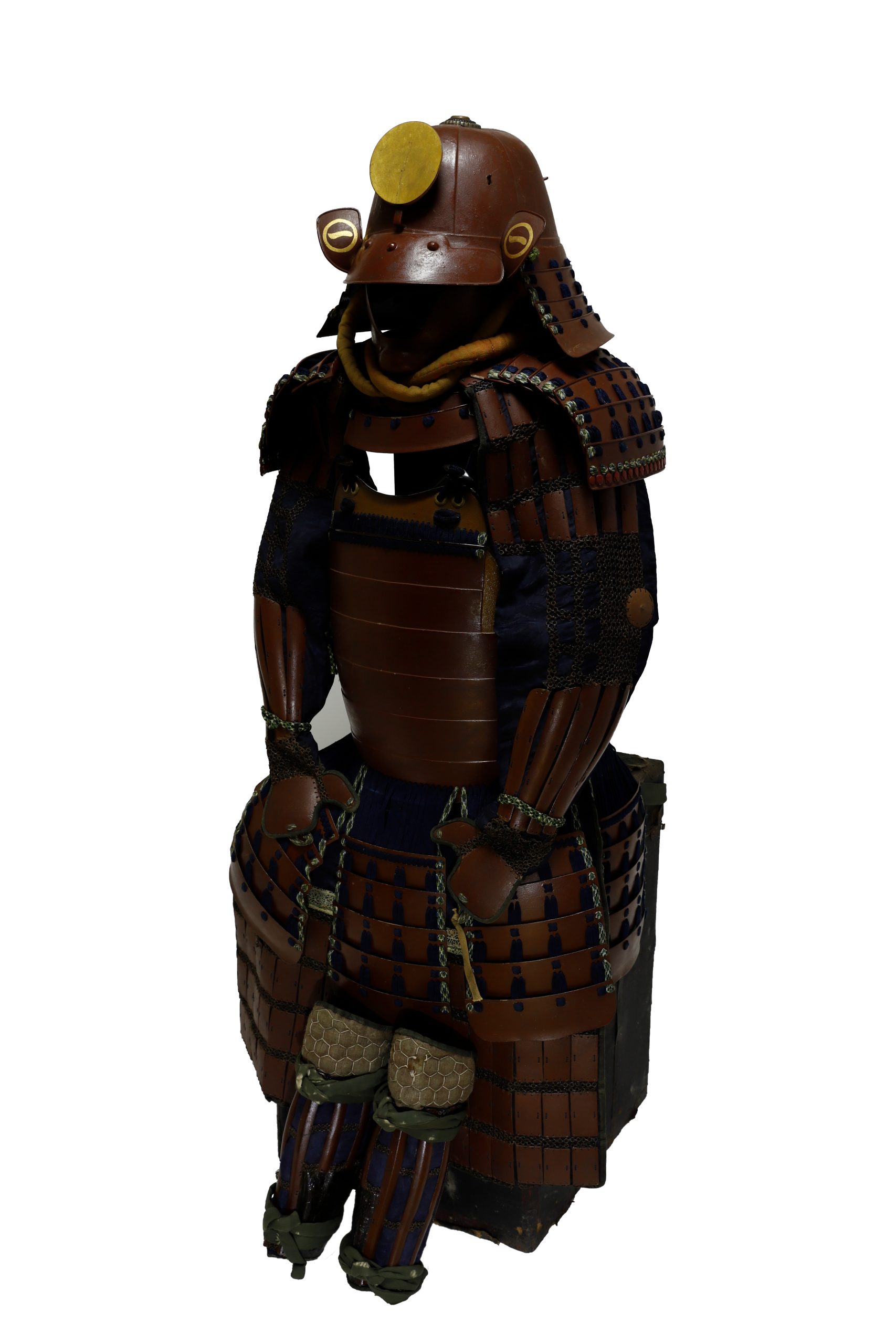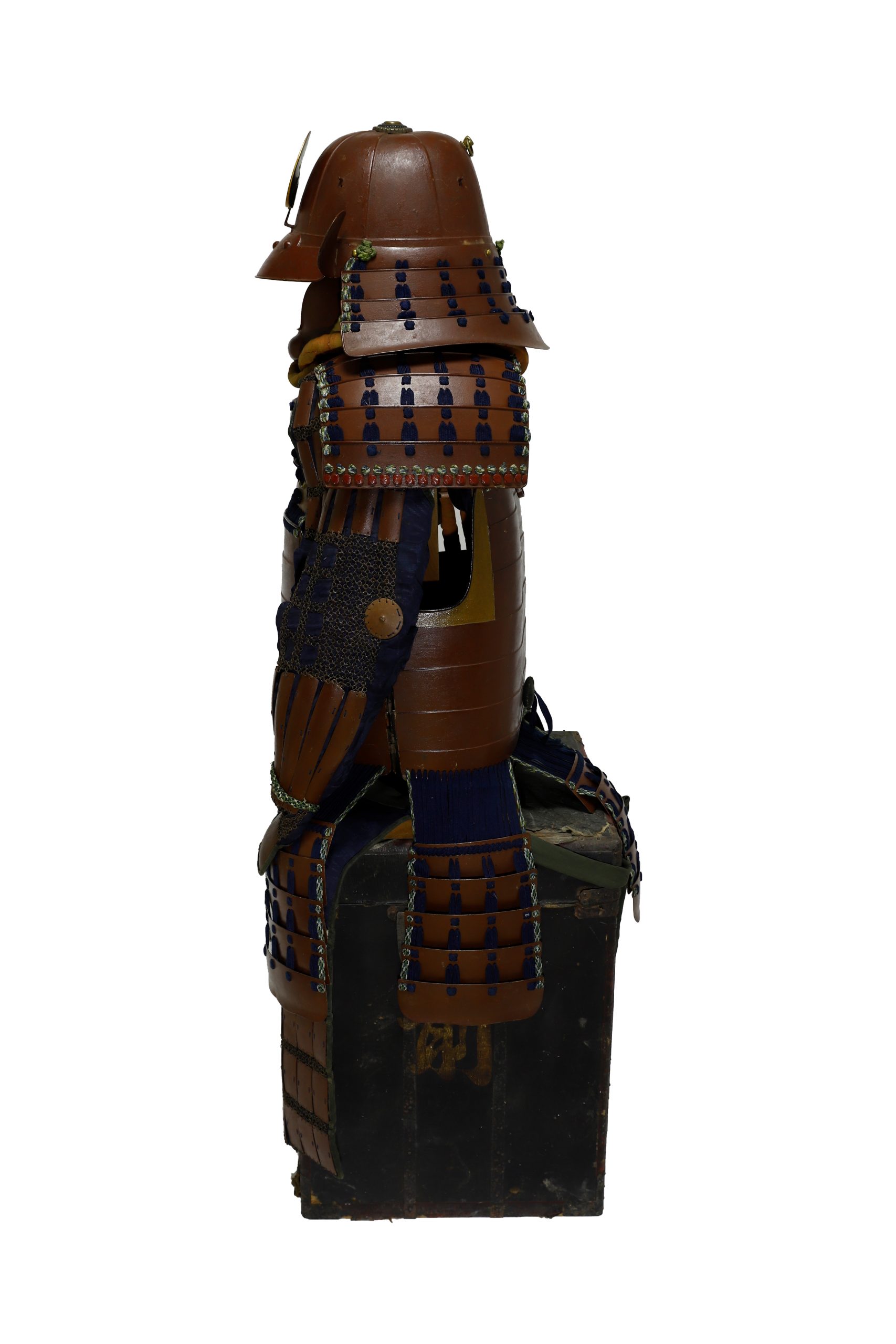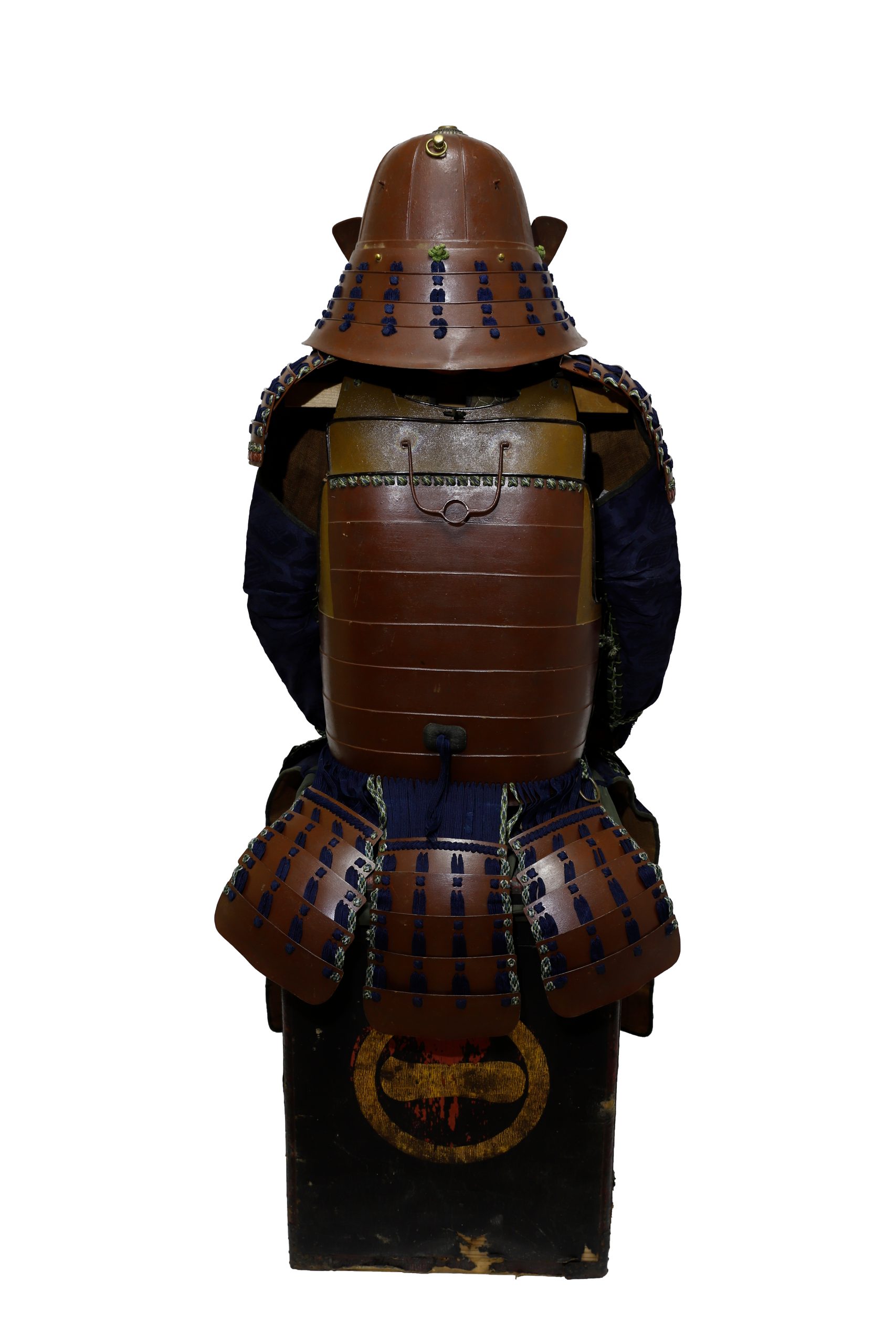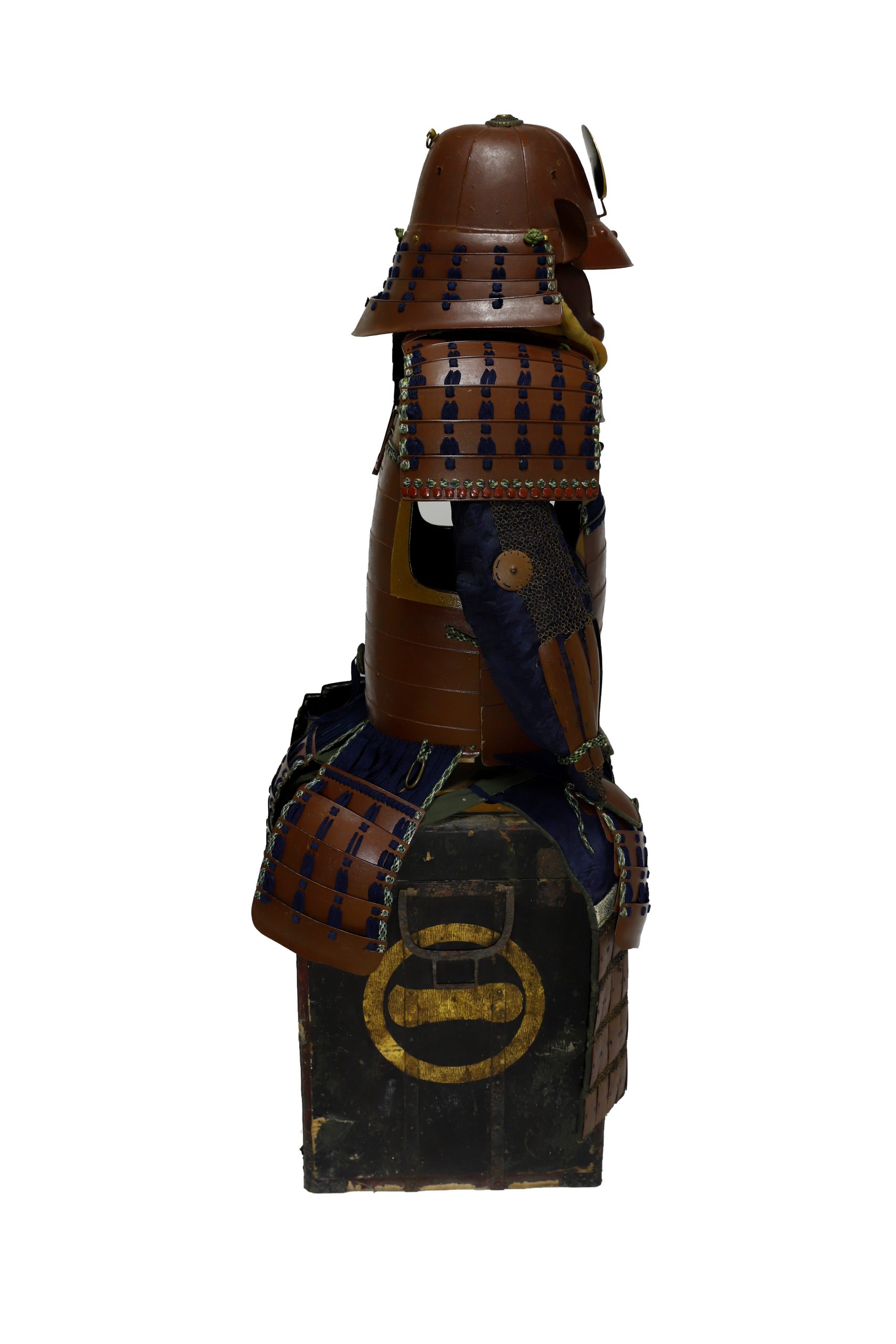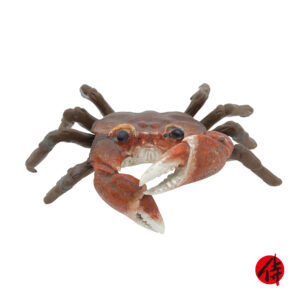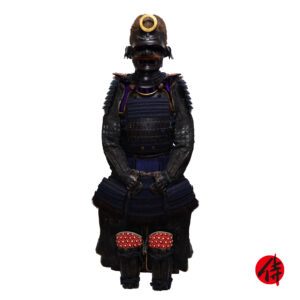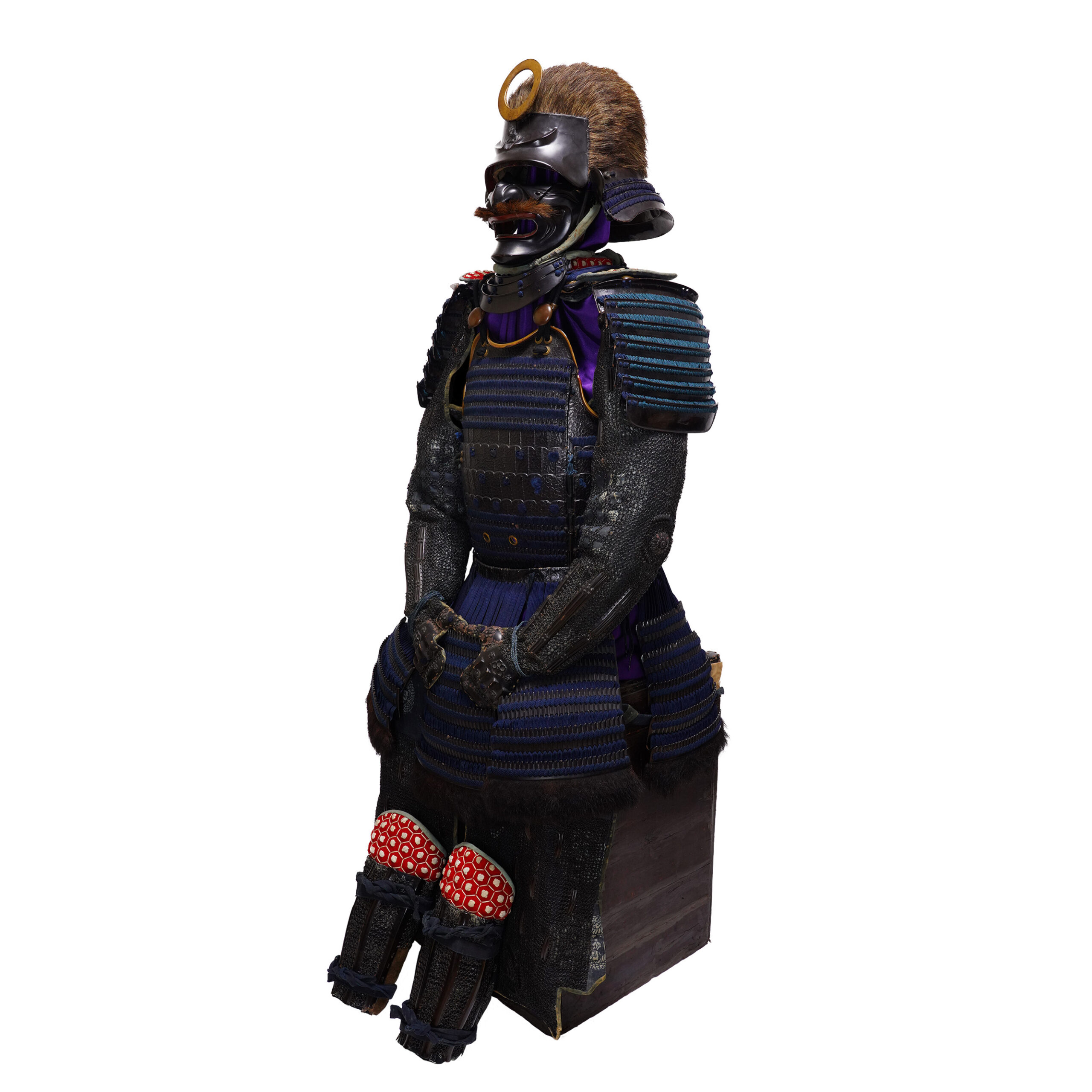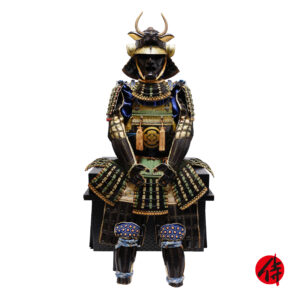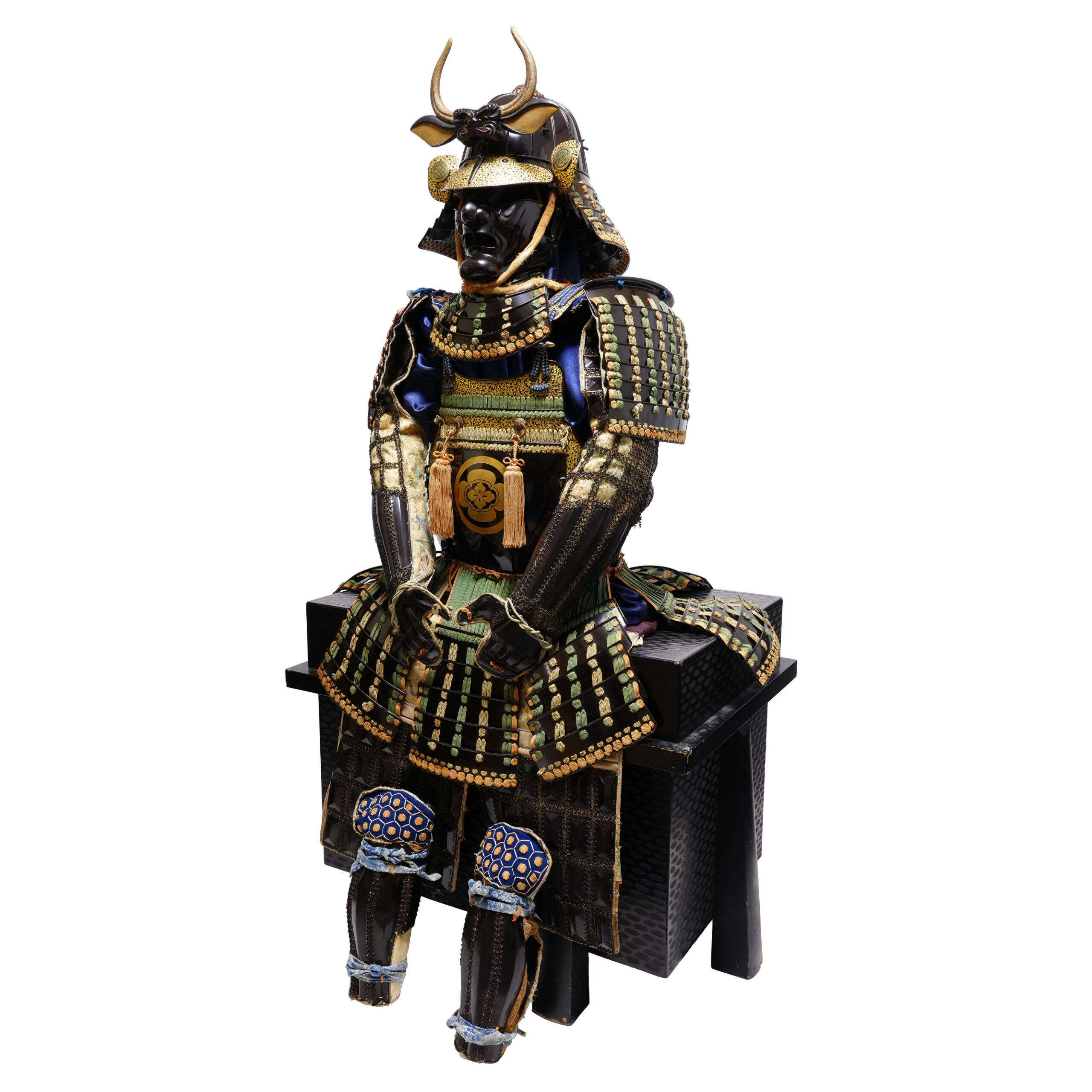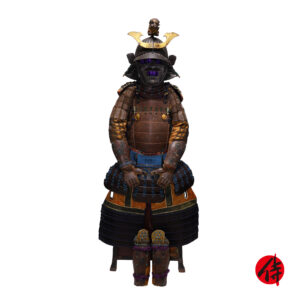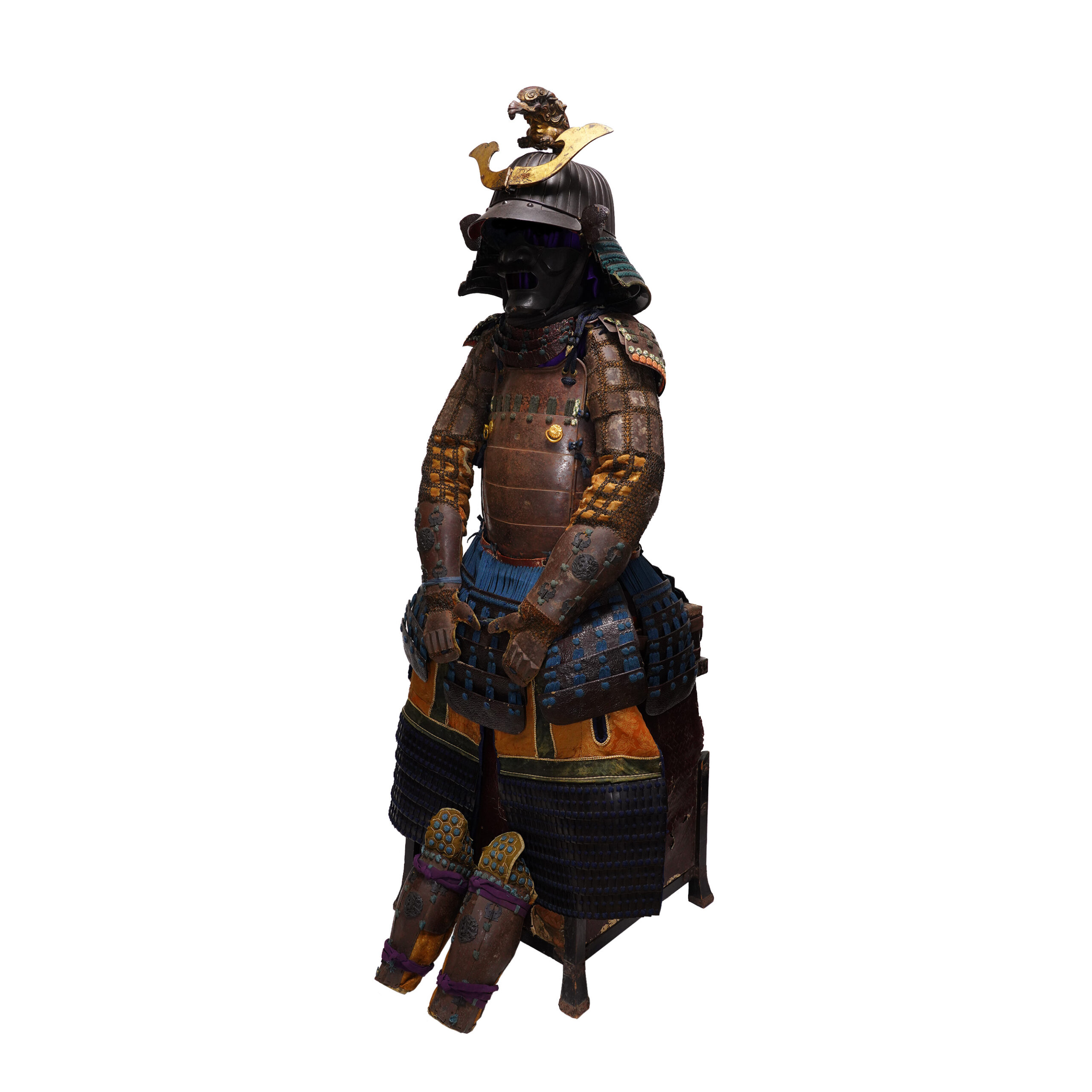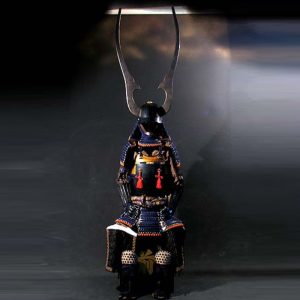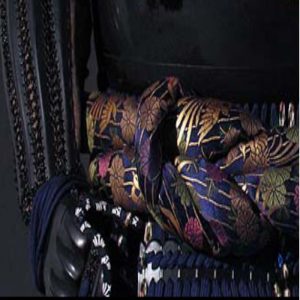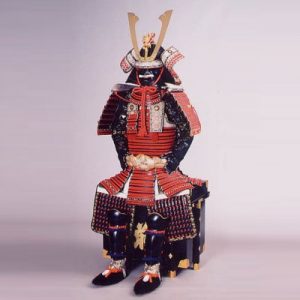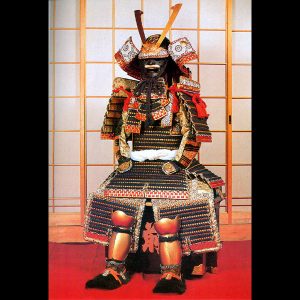Antique Brown Lacquered Mid Edo Period Samurai Armor with Tokubetsu Kicho Shiryo Certificate (A-09)
Period: middle of the Edo Period
appraised by The Association for the Research and Preservation of Japanese Helmets and Armor
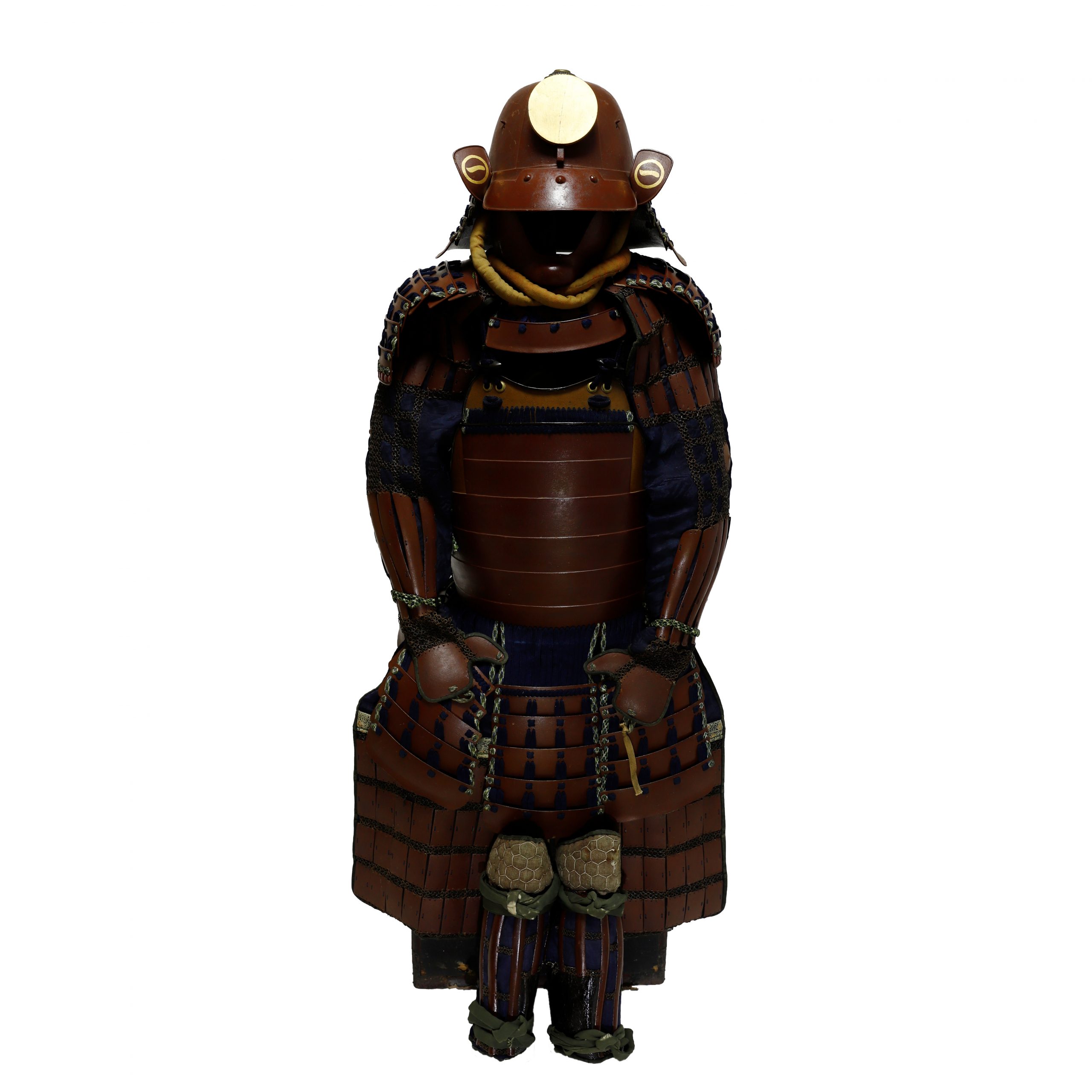
Kabuto (helmet)
■Helmet bowl: brown lacquered Kabuto (helmet)
The surface is coated with brown lacquer.
■Shikoro (side neck guard)
Iron plates laced with navy blue
■Menpo (face guard): brown lacquered iron half mask
This type of half mask was popular as it was easy to breathe compared to the full mask that covers his nose.
■Maedate (front decoration): Nichirin or the moon
The motif of this helmet’s Maetate (前立, front decoration) is probably the Nichirin (日輪, another name that means the sun) or the moon. There was a widespread belief among Samurais; the Myouken (妙見) belief. This religion was born in India. It was mixed with the Polestar belief and was brought to Japan from the Continent. The sun, the moon and stars of the entire universe were the symbols of faith. The Myouken Bosatsu (妙見菩薩, 菩薩 means Bodhisattva) fulfills all wishes such as fertility of rich harvest, peace, the prosperity of the clan, healing of illness, longevity, success in business, traffic safety, academic achievement, marriage, etcetera. So, it is understandable that the sun (or moon, in this case) motif was appreciated among Samurais. The former owner of this armor might have had shown his faith wearing this helmet.
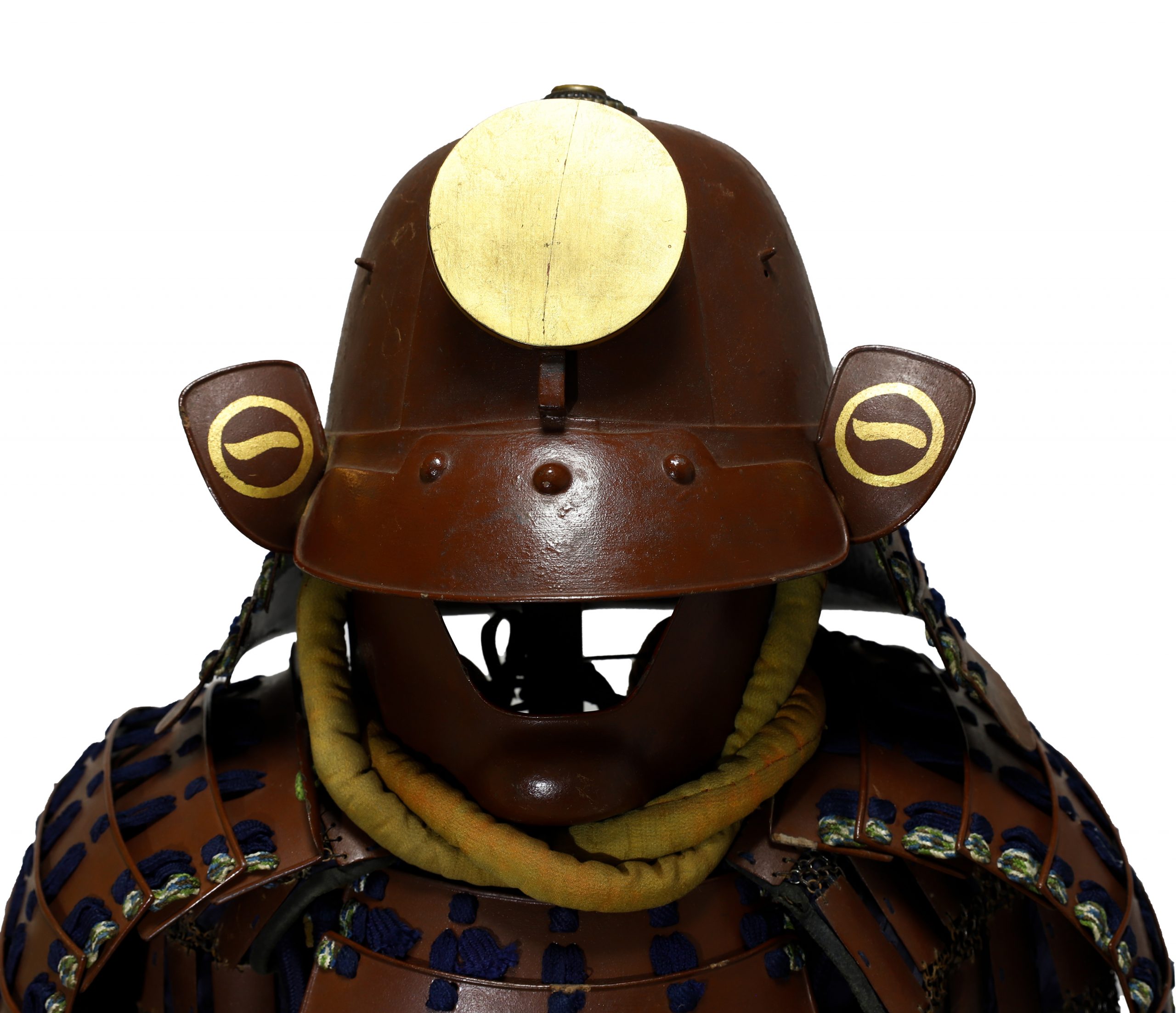
■Fukikaeshi: family crest; Maru-ni Ichimoji/Ichimonji Mon
Now, please focus on the Fukikaeshi (吹き返し) part of this helmet. You see the golden mark; it is a kind of the family crest and is categorized as the Maru-ni Ichimoji/Ichimonji (丸に一文字) pattern. The “一” is a Japanese Kanji character that means one, first, start etc. According to a theory, the Maru-ni Ichimoji pattern is a family crest that imitates the “一” letter, and people interpreted this mark as “Katakinashi (無敵, invincible/unconquerable).” Therefore, it is said then Samurais liked it to use on the battlefields, and they read this letter as “Katsu” to link the Japanese word Katsu (勝つ), that means win. We could imagine that many Samurais loved this design.
You will find the same mark on this armor’s box.
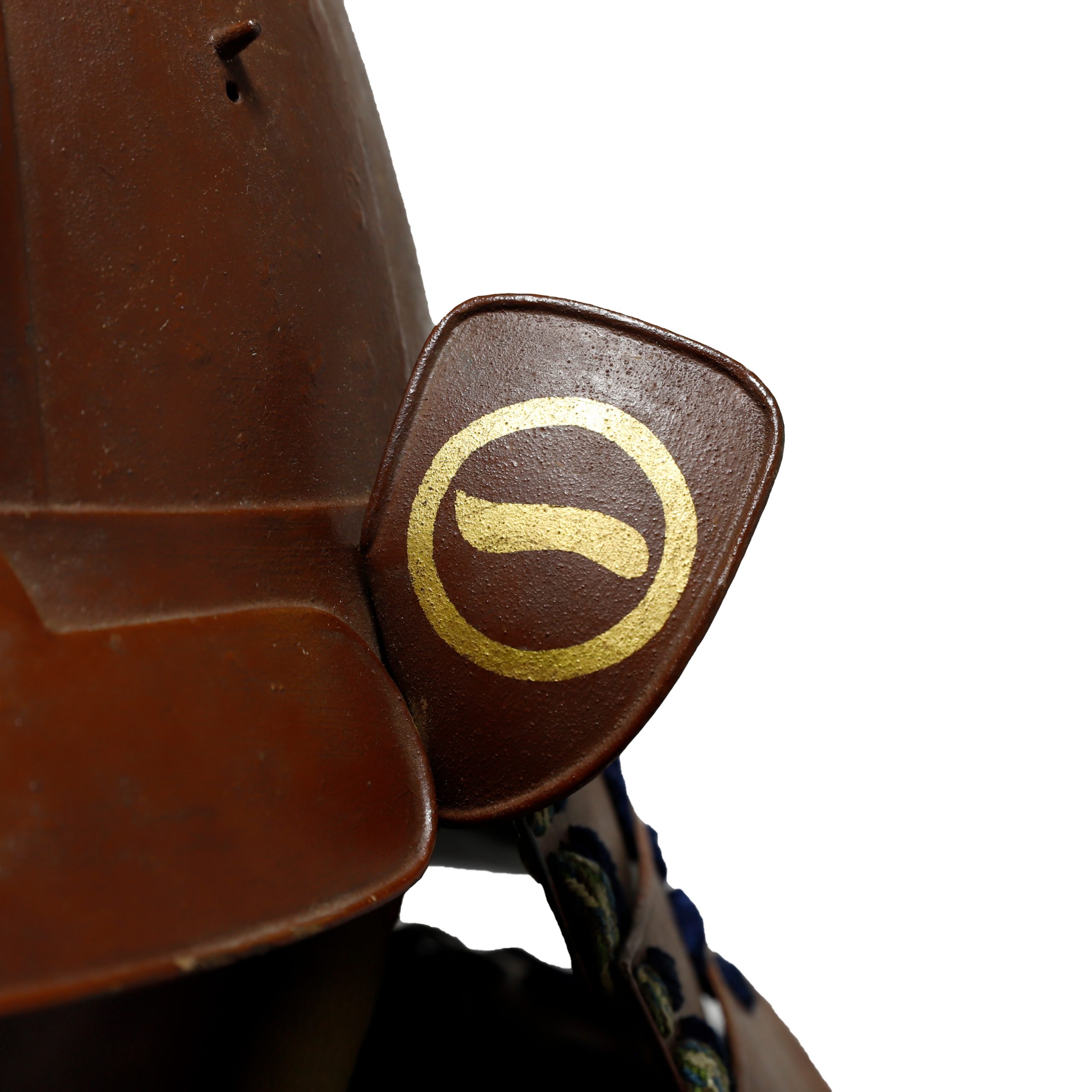
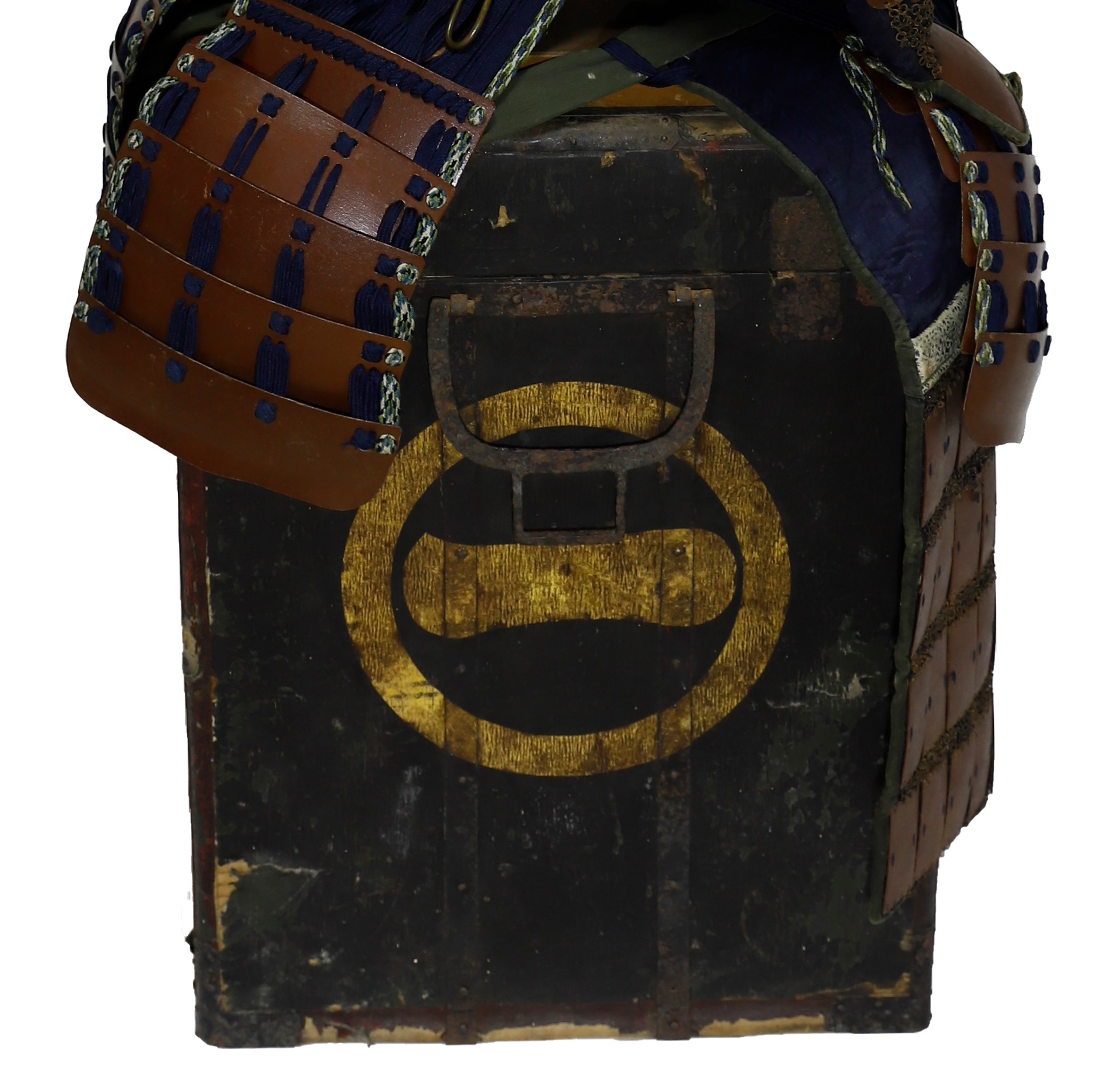
Armor
■Do (cuirass): Okegawa Nimai Do
Nimai Do is a kind of cuirass for Tousei Gusoku (developed armor style). Nimai Do was named after the fact that Nimai means two plates, and Do means torso in Japanese. Instead of using a large number of small lamellar plates called Kozane, this cuirass used large rectangular shaped iron plates riveted.
The name Okegawa came from the fact that the shape of this cuirass resembles the side (Gawa in Japanese) of Oke (Japanese wooden tub). The body armor part can be separated into two pieces and connected with a hinge. Typically, the hinge is located on the left side, and you can tighten this cuirass on the right side.
■ Decoration on body armor:
■Sode (shoulder guards): Tetsusabiji iron Sode laced with navy blue thread
■Kusazuri: lacquered iron Kusazuri laced with navy blue thread
Kusazuri is a skirt of plates attached to the cuirass
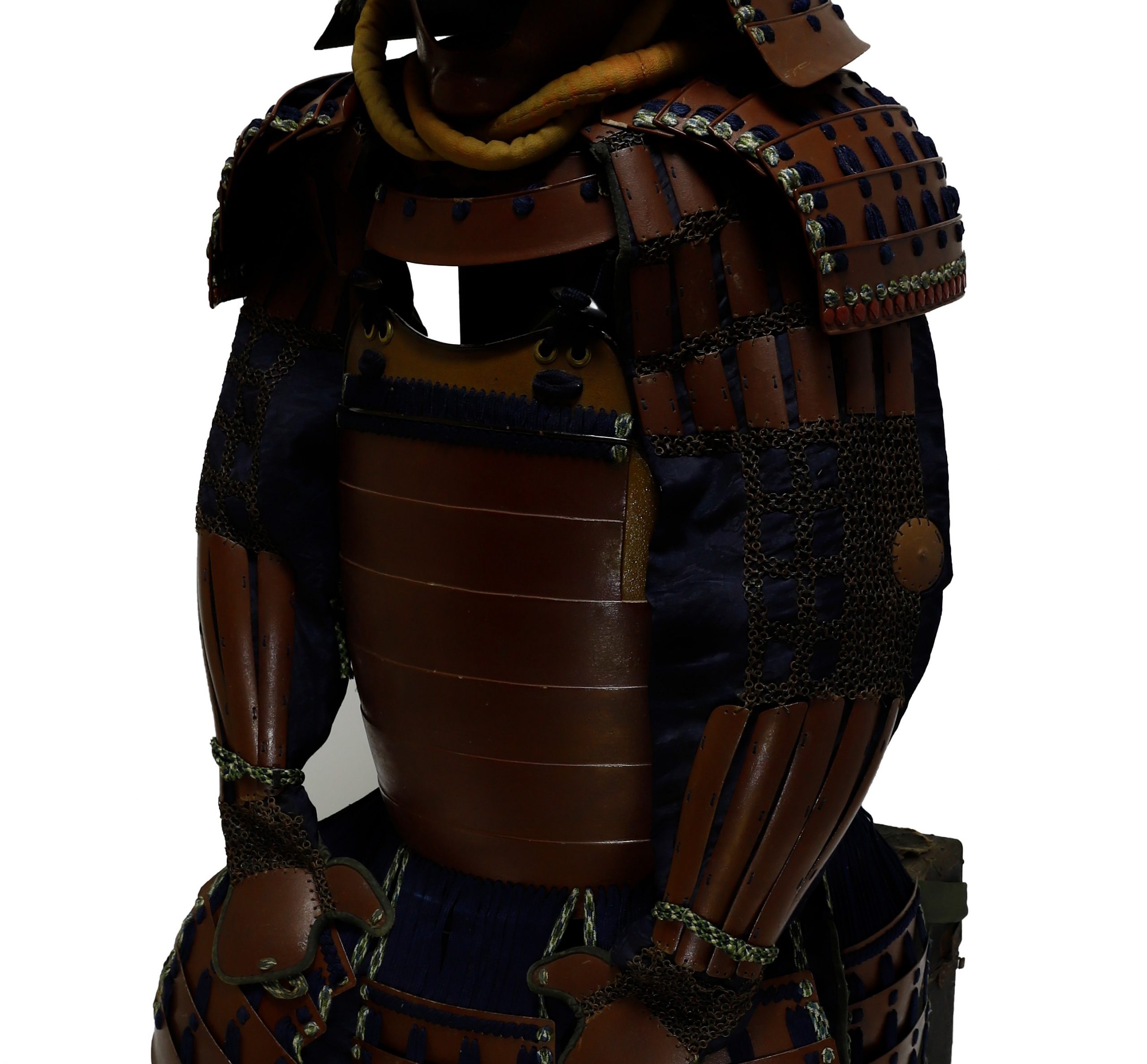
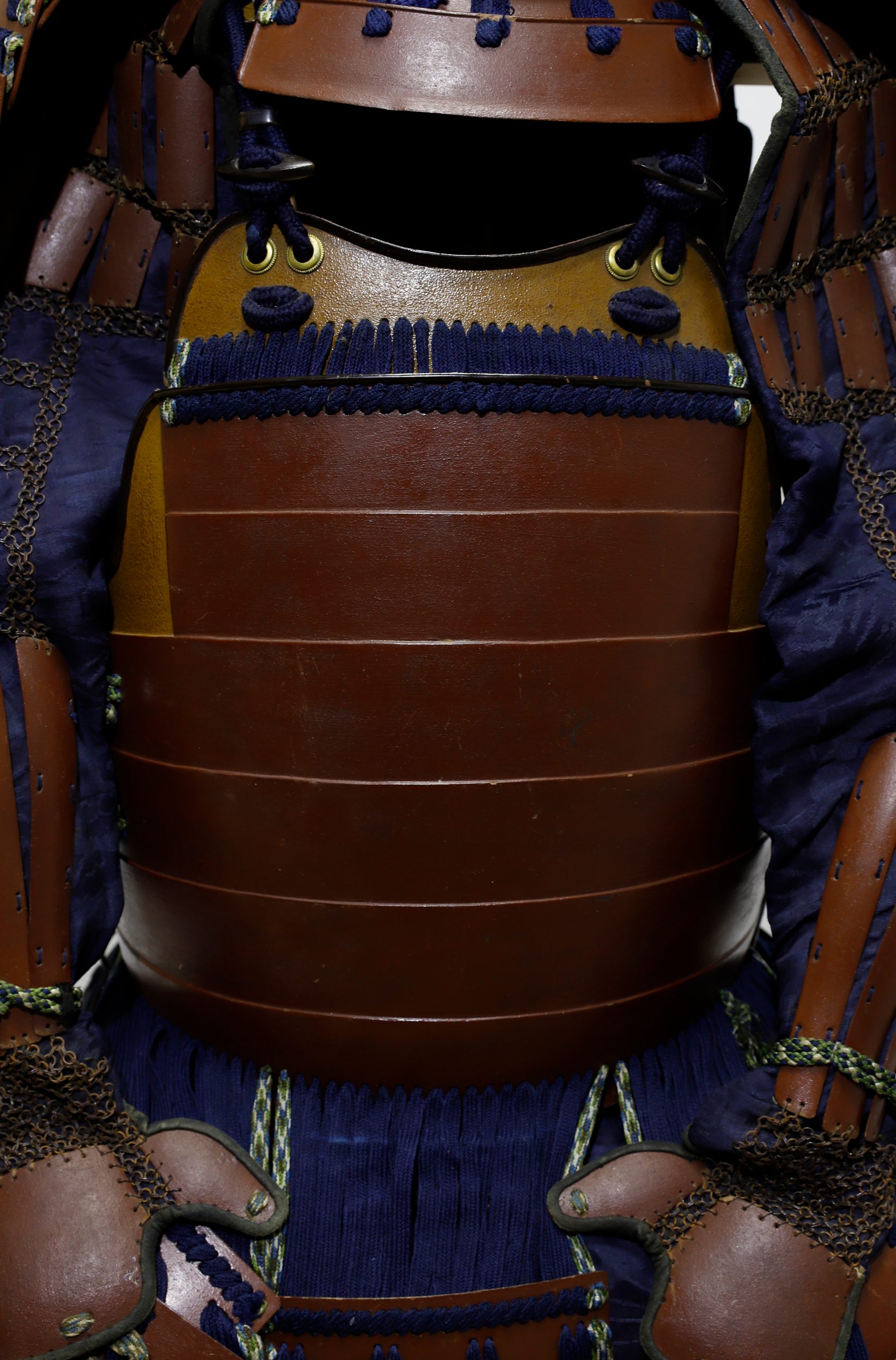
Small parts
■Kote (armored sleeves): intricate iron chain mail with silk
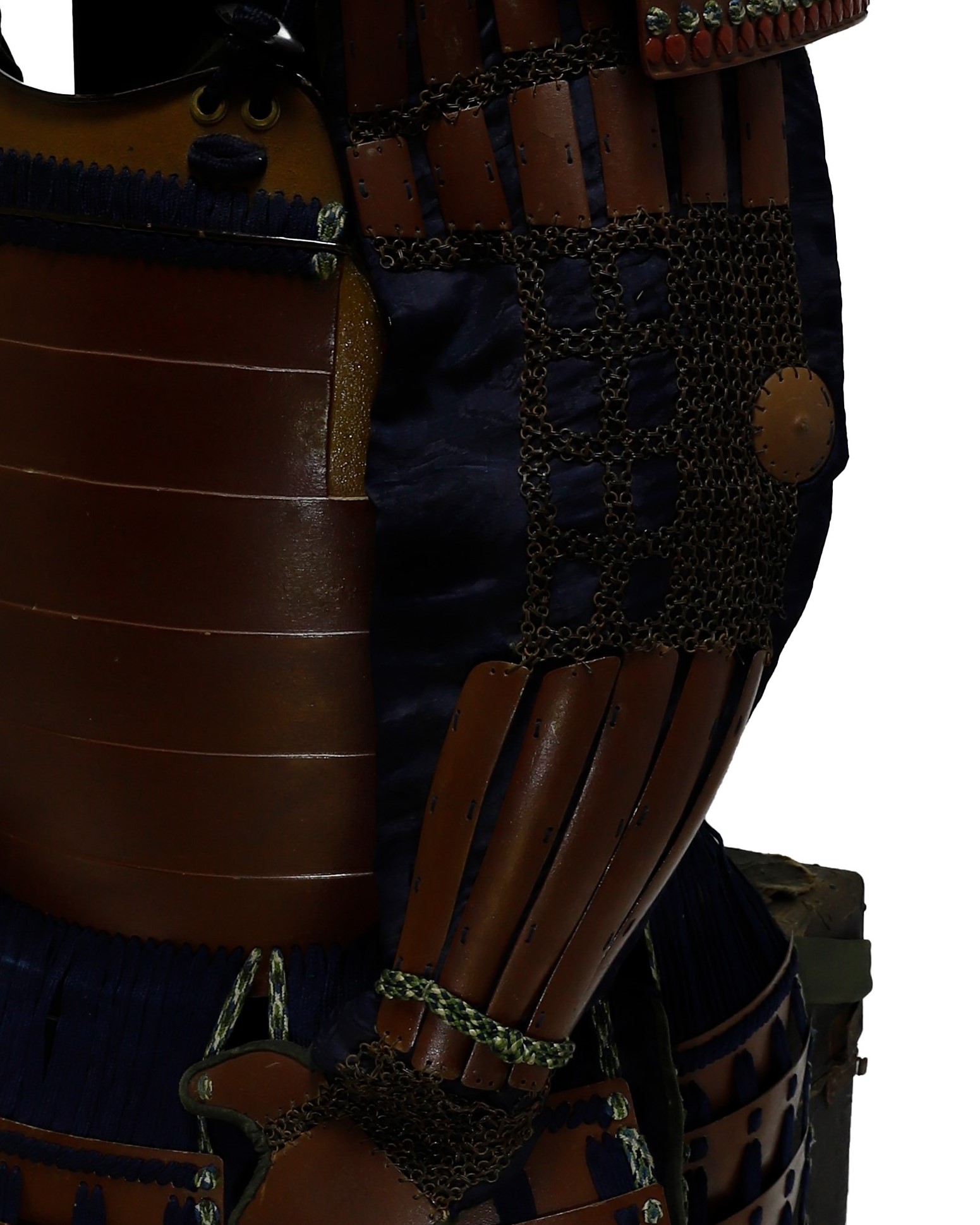
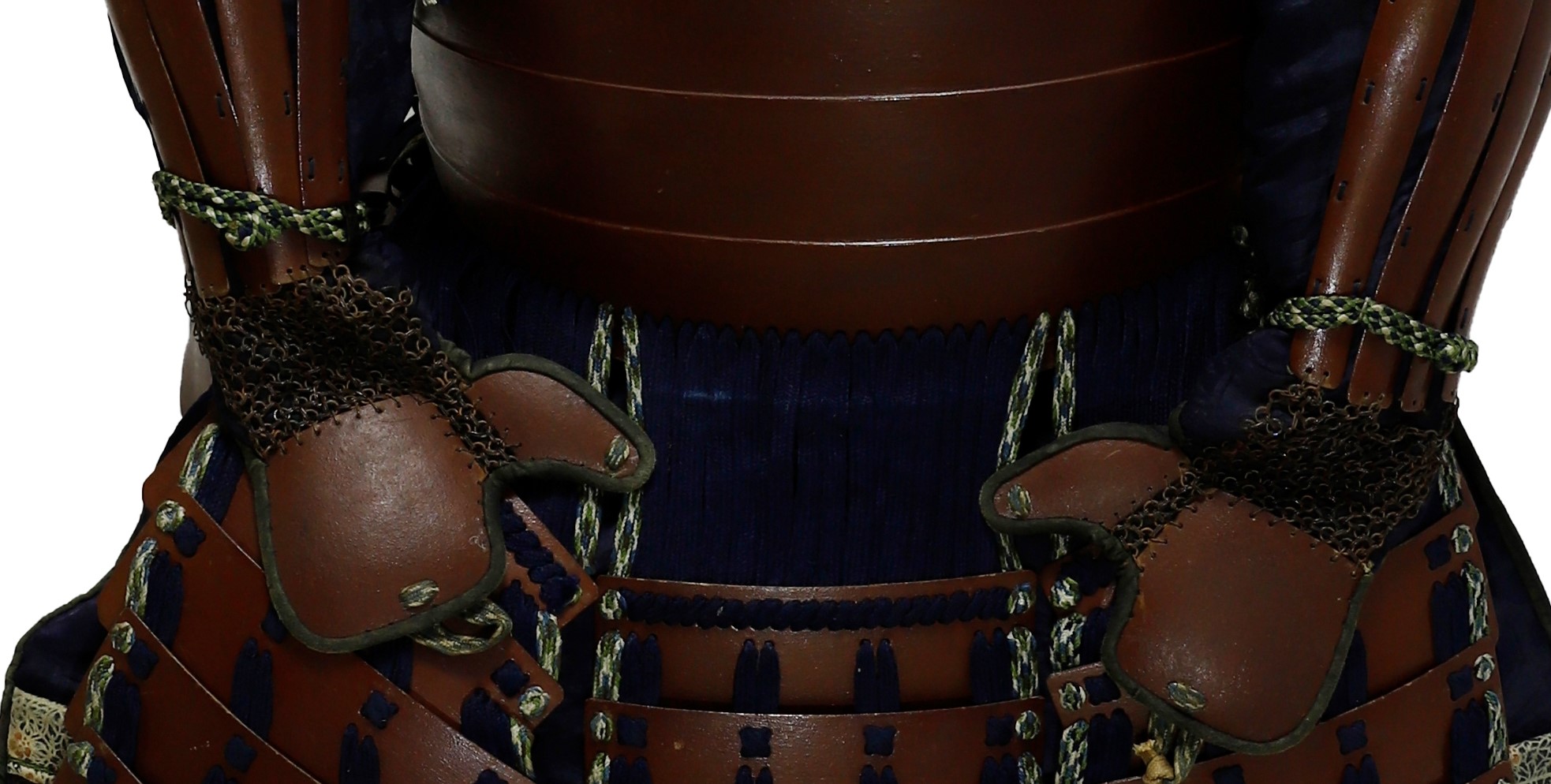
■Haidate (thigh protection): Haidate is a shin guard
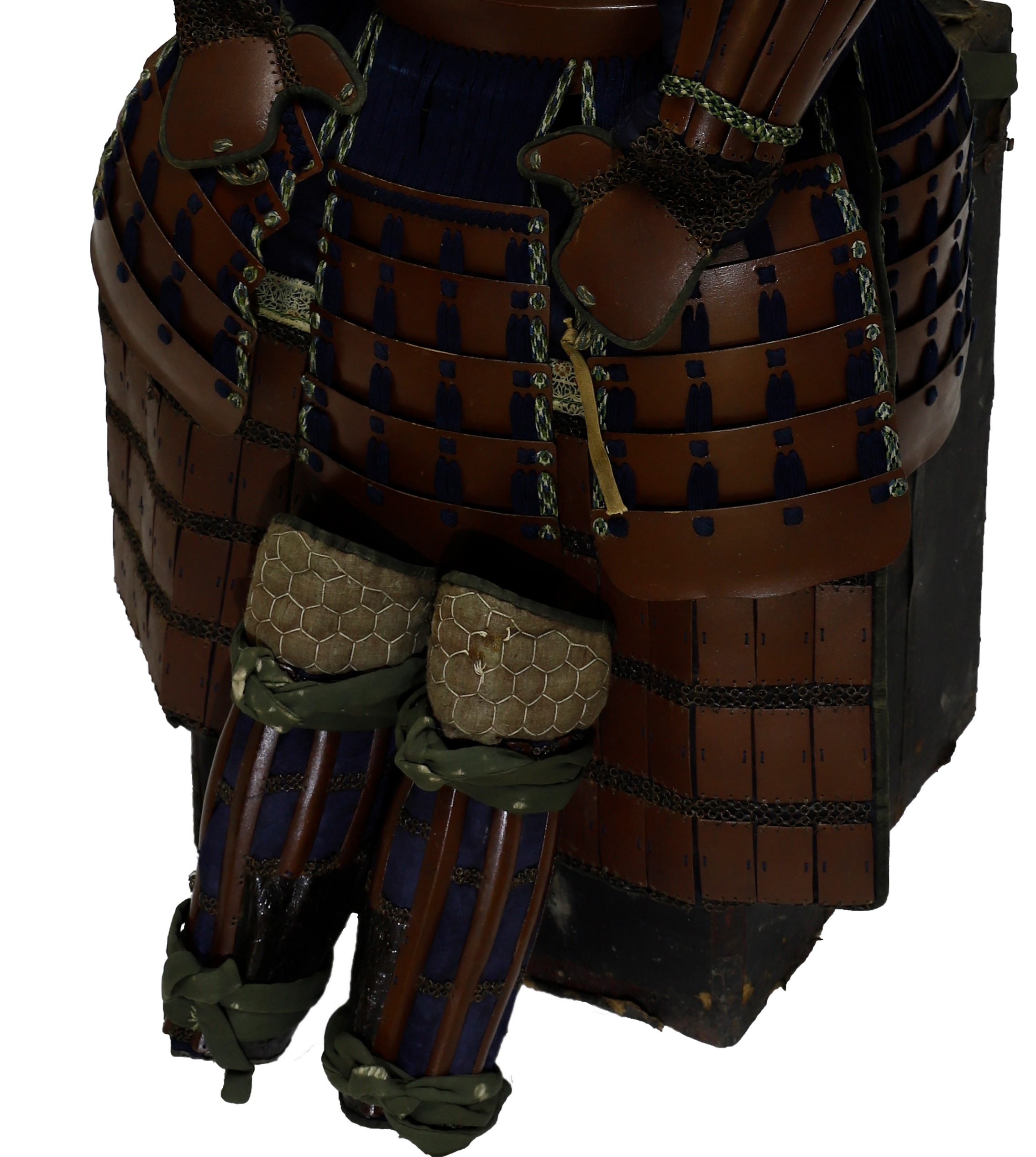
■Suneate (Shin guard): lacquered iron Suneate
The Kikkou (亀甲, turtle’s shell) pattern is used for the cloth of leg guard. It is a continuous geometric pattern connecting regular hexagons up and down. A theory says that this design was brought from China and the Korean Peninsula in the Asuka (592-710), Nara period (710-794). A proverb says turtles live a long life; therefore, turtle and turtle’s shell pattern represent longevity. In addition, as this continuous hexagonal pattern does not get out of its shape, it is said people wished for eternal prosperity by using this design.
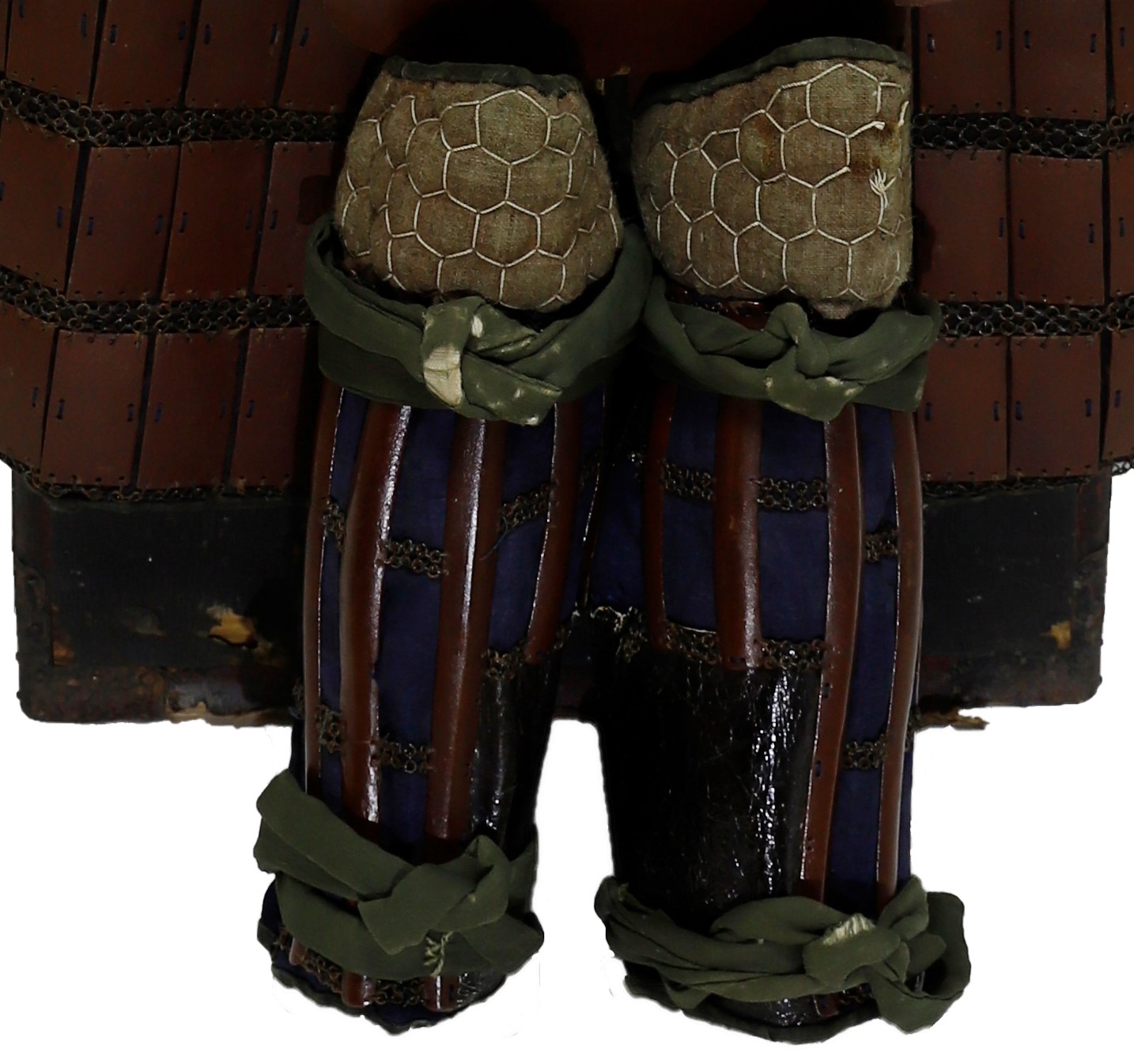
■Nadokoro (flag holder):
If you focus on the back of this armor, you will find that a metal ring-shaped part is attached to there. Its center ring was used to insert a flag. There was also metal tube-type gear that had the same role. Samurais put flags into these tubes or rings and judged their side and enemies on the battlefields. Especially in group battles with infantry, this method was very effective because they could instantly identify affiliations.
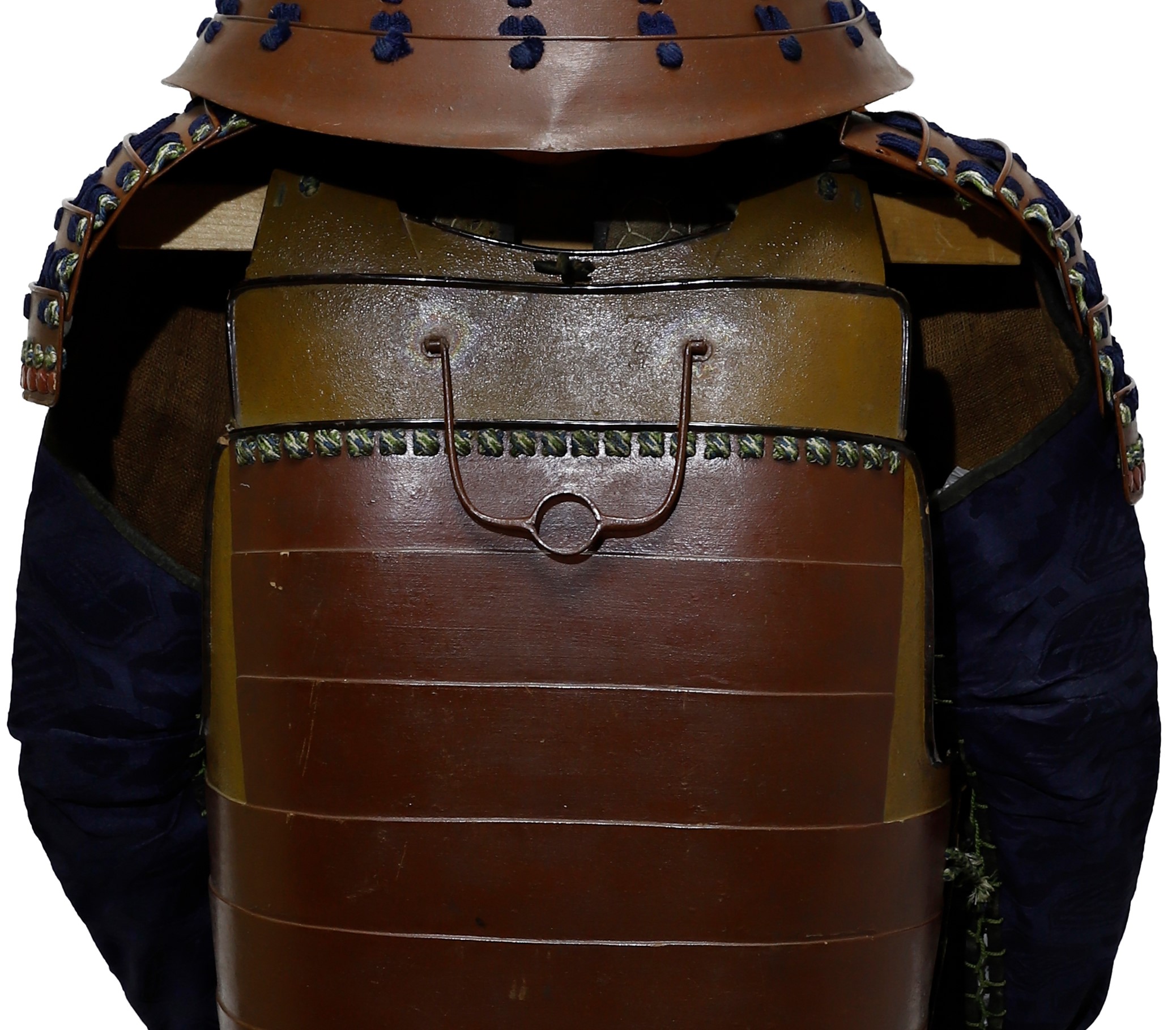
Certification: Tokubetsu Kicho Shiryo Certificate
The certificate will be issued by The Association for the Research and Preservation of Japanese Helmets and Armor, which is the most trusted Japanese armor appraiser in Japan. Tokubetsu Kicho Shiryo means an especially precious cultural article. It is ranked as the third highest of five rankings.
This armor was authenticated on October 10th 2021 as Tokubetsu Kicho Shiryo and the paper will mention the armor was made in the mid Edo period.
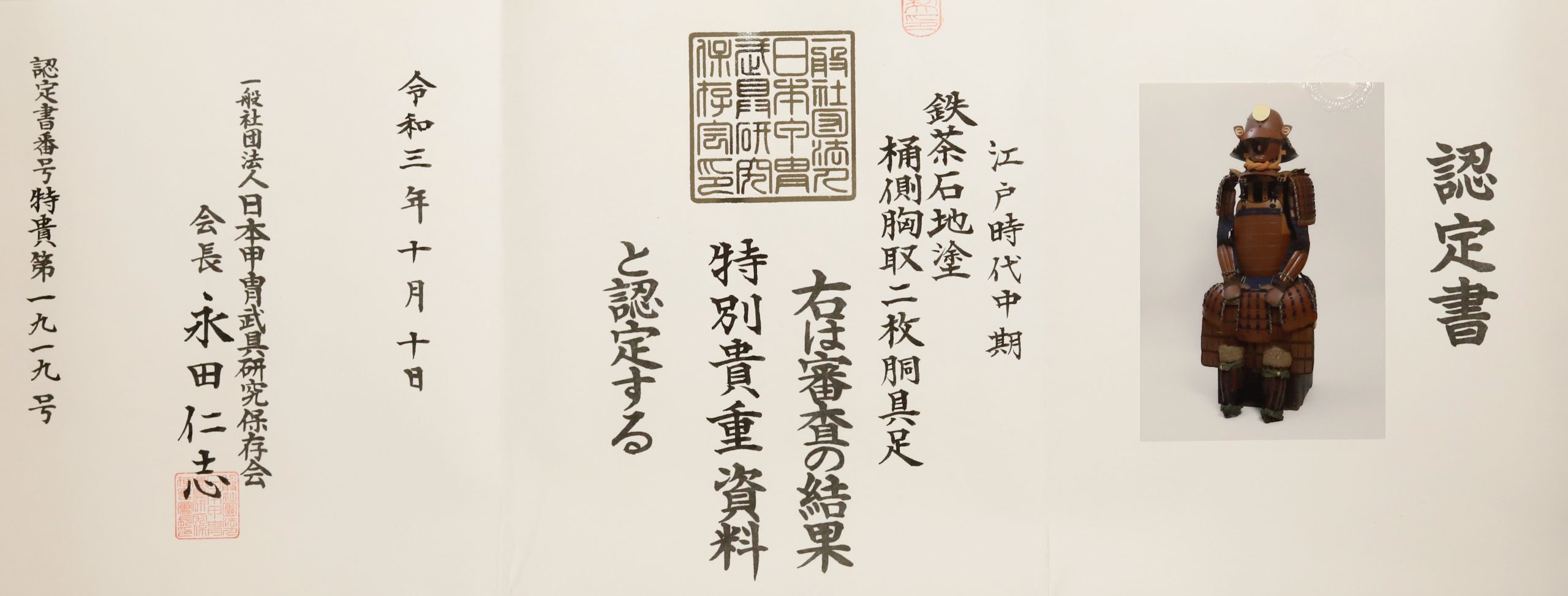
An English translation of the certificate is available on request. We won’t charge any additional fee.
【About us】
Samurai Museum is located in Tokyo, Japan, exhibiting antique artifacts related to the Samurai history. Samurai Museum Shop is the place for those who are interested in Japanese culture and craftsmanship. We deal with antique Samurai swords/armor, traditional crafts made in Japan and so on.
【Antique Japanese Armor and Export process】
After receiving the full payment from you, we will apply for its export permit from the agency for Cultural Affairs to legally export the antique Samurai armor to other countries. It normally takes around 2-4 weeks to receive this permit. And we would like you to expect at least 1-1.5 months for your order to arrive at your given address after you ordered.
【Payment method】
We accept payment through Stripe (Credit card), PayPal, Apple Pay or ChromePay, all of which are secure payment methods. Also, you don’t need to make an account on Stripe for the checkout. If you prefer other payment method, please contact us. You may either pay in JPY, USD, AUD, CAD, EUR, CHF or GBP. The price is set in Japanese Yen. Prices in other currencies are automatically calculated based on the latest exchange rate.

【Shipping duration】
We normally ship via EMS (Express Mail Service) provided by Japan Post. It usually takes at least 5-14 days to deliver the package after you place an order. We offer Free International Shipping as long as we can ship your order by EMS. If you prefer other shipping carriers, please contact us.
We will inform you of the order’s tracking number via email. Please make sure you fill out your valid email address correctly.
*Please keep in mind that due to the spread of COVID-19, there might be possible delays in delivery. If you like to make sure if EMS shipping is available to your country, please contact us.

【How to make sure the condition】
Please keep in mind that what you are going to purchase is an antique item. We uploaded high resolution photos for you to check its condition thoroughly. If you like to see more photos with different angles, please feel free to contact us. We will be happy to send them to you so that you can make informed decision. It is essential for us to know that you are happy with your choice of a sword. and we are prepared to use the best of our ability to serve you.
【How To Contact Us】
Please contact us through email, Facebook Messenger or Live Chat if you have any questions. You can find each icon on the right side of the website. Please click one of them to reach us. We will reply to you within 1-2 business days.
【How To Preserve Antique Samurai Armor】
Dryness, humidity, and bad ventilation might deteriorate the condition of antique Samurai armor. The best temperature to preserve Samurai armor is around 20℃ in Celsius, and humidity should be about 60%. Direct sunlight should be avoided. We recommend storing armors in a room with good ventilation. If you like to display them outside the boxes for a prolonged time, we suggest using a glass case in order for dust not to be accumulated easily. In case you don’t use a glass case, please make sure to regularly dust off from the armor by using a soft brush made of delicate cloth or brush for painting.
If you like to know more about the preservation of this armor, please feel free to contact us.
